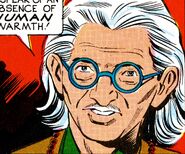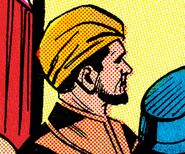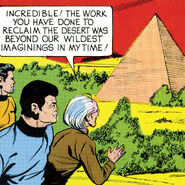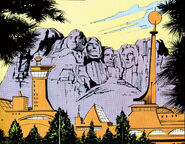Prophet of Peace was a comic book story published by Gold Key Comics in 1976. In this story, a scientist and pacifist was cryogenically frozen in the 1990s and revived by the crew of the USS Enterprise in the year 2266. He takes a tour of 23rd century Earth and promotes peace.
Publisher's description
- Cover blurb:
- Frozen sleep in the depths of space!
Summary
| This article or section is incomplete |
|---|
| This article is marked as lacking essential detail, and needs attention. Information regarding expansion requirements may be found on the article's talk page. Feel free to edit this page to assist with this expansion. |
References
Characters
- Abdula • Alfred Bleikoff • Hershkoqitz • James T. Kirk • Leonard McCoy • Rajipur • Spock • Montgomery Scott • Sellers • Hikaru Sulu • Nyota Uhura • unnamed USS Enterprise personnel • unnamed Humans (Stockholm police foreman, protestors, Nobel Prize host, journalist, Earth councillor) •
- Referenced only
- Henry David Thoreau
Starships and vehicles
- USS Enterprise (Constitution-class) • transport craft
Locations
- Colosseum (Rome) • Eiffel Tower (Paris) • Great Pyramid (Giza) • Jerusalem • Mariana City (Pacific Ocean) • Mount Everest • Mount Rushmore National Memorial • O'Hare Rocket Port (New Chicago) • Statue of Liberty (New York City) • Stockholm • Taj Mahal (India) • Earth (Sol system)
Races and cultures
- Human • Vulcan • unnamed races and cultures (alien reprogrammers, alien journalists)
States and organizations
- Earth's government • Federation • Interplanetary Press • Port Inspectors’ Association • Starfleet • Supreme Council of Earth
Science and technology
- astronomy • astrophysics • bacteria • bacterial weapon • blood • brain • computer • cryonics • Earth defense screen • environmental suit • eyeglasses • fish • hypnosis • magnet • mathematics • nuclear weapon • radio • star • star system • steri-bath • tractor beam • quarantine • universe • x-ray
Ranks and titles
- captain • chief engineer • chief medical officer • commander • commanding officer • doctor • first officer • general • helmsman • lieutenant • lieutenant commander • mayor • professor • science officer
Other references
- captain's log • civilization • donation • electricity • energy • government • lifeform • log entry • logic • Mount Hebron • Nobel Prize • orchid • philosophy • planet • poetry • politics • police • Prime Directive • Rip Van Winkle • rose • Space News • stardate • Starfleet Headquarters • tea • Vulcan orchid
Timeline
Connections
| published order | ||
|---|---|---|
| Previous comic: #38: One of Our Captains is Missing! |
TOS comics (Gold Key) |
Next comic: #40: Furlough to Fury |
| chronological order | ||
| Previous Adventure: Child's Play |
Memory Beta Chronology | Next Adventure: The Planet of No Return |
Appendices
Background
- This story, written in 1976, was noteworthy for being the first time a Star Trek comic was explicitly set on 23rd-century Earth. Although it was implied that an earlier story, TOS comic: "The Trial of Captain Kirk", took place in San Francisco, that location was not named in the story. The next story, TOS comic: "Furlough to Fury", was also set on Earth.
- Bleikoff’s world tour covered several continents of Earth, including North America, Europe, and Asia, as well as New Chicago on Luna. It also included travel via two distinct transport craft. The transporter was not used in the story.
- The Eiffel Tower and Colosseum visited in this story were destroyed later that same year, on stardate 2417.9, along with the Great Sphinx and Leaning Tower of Pisa. (TOS comic: "The Voodoo Planet")
- Alfred Bleikoff won the Nobel Prize for his theory of the origin of the universe. The Big Bang theory was first proposed by Georges Lemaître in the 1920s. An early version of the Grand Unified Theory was first proposed in 1974, two years before this story was written. Bleikoff might have worked on some aspect of that theory or a forerunner of the Unified Field Theory.
- The Nobel Prize awarded in the category of astrophysics is actually just called the Nobel Prize in Physics. In 1995, Martin Lewis Perl won the award. By coincidence, he somewhat resembles Bleikoff.
- It was not explicitly stated when Bleikoff won the Nobel Prize, inspired a war to end, fell victim to an incurable disease, or was cryogenically preserved in space, but the elapsed time between these events did not seem that long since he looked the same. McCoy said that Bleikoff’s cryogenic capsule “was their first such experiment.” A similar cryogenic process was done to several individuals shot into Earth orbit in a spacecraft in 1994 (TNG episode: "The Neutral Zone"), so Bleikoff’s turn of events would have happened around this time. The war could have been either the Persian Gulf War or the Eugenics War. It’s plausible that he won the award in 1990, saw the Persian Gulf War end in 1991, and was put in space by 1994 as the "first major effort in cryonics." It’s also plausible that Bleikoff won the award in 1995, saw the Eugenics War end in 1996, then shortly thereafter was put into space, with the first experiment being that of using cryogenics in a coffin-sized capsule rather than a spacecraft. Supporting that possibility, Brand and Chang also participated in a peace movement against the Eugenics War. (TOS comic: "Sceptre of the Sun")
- Other 1990s humans who survived cryogenics in sleeper ships included Khan Noonien Singh, his Augments, and the pacifist group which included Brand and Chang. L.Q. Clemonds, Clare Raymond and Ralph Offenhouse survived cryogenics in a spacecraft. Doctor Stavos Keniclius survived through cloning.
- Bleikoff appears to look like a combination of Mahatma Gandhi and Albert Einstein.
- The steri-bath in this story strongly resembled the decontamination chamber aboard NX class starships. Decontamination was normally handled by the transporter, so it might have been under repair at the time. (TOS episode: "The Naked Time")
- The Mariana Trench, a likely site for Mariana City, is a trench in the Pacific Ocean with a maximum depth of 36,200 feet, consistent with the 30,000-foot depth cited in the story.
- The mountain range seen during Bleikoff’s tour was not named, but it probably was Mount Everest in the Himalayas. They were en route to India, with one of the defense screen facilities visible there. As they are “spread around the world at various high points,” and Mount Everest is the highest point, it seems a likely spot for a facility.
- The news media on Earth were depicted in a decidedly 20th-century manner, with a printed “Space News” newspaper, TV sets, and a broadcast studio with a large video camera. A reporter jotted down his notes on a pad of paper.
- New Chicago’s O'Hare Rocket Port was named after Chicago’s O'Hare International Airport.
- The notion of Bleikoff as a Rip Van Winkle-of-Space refers to the 19th century short story “Rip Van Winkle” by Washington Irving, in which the character of Van Winkle sleeps through 20 years of history, including the American Revolution.
Related stories
- TOS episode: "Space Seed" – The Botany Bay spacecraft launched from Earth in 1996 is discovered. Khan Noonien Singh and his Augments are revived from cryogenic freeze.
- TAS episode: "The Infinite Vulcan" – Eugenics Wars survivor Stavos Keniclius was found to have survived into the 23rd century through a cloning process.
- TNG episode: "The Neutral Zone" – Several individuals were revived who had been cryogenically frozen and shot into Earth orbit in a spacecraft in 1994.
- TOS comic: "Furlough to Fury" – The next Gold Key comic story, which also takes place on 23rd century Earth and Luna.
- TOS comic: "The Voodoo Planet" – The Eiffel Tower and Colosseum were destroyed, along with the Great Sphinx and Leaning Tower of Pisa.
Images
External links
- Prophet of Peace article at Memory Alpha, the wiki for canon Star Trek.
- Nobel Prize Website












